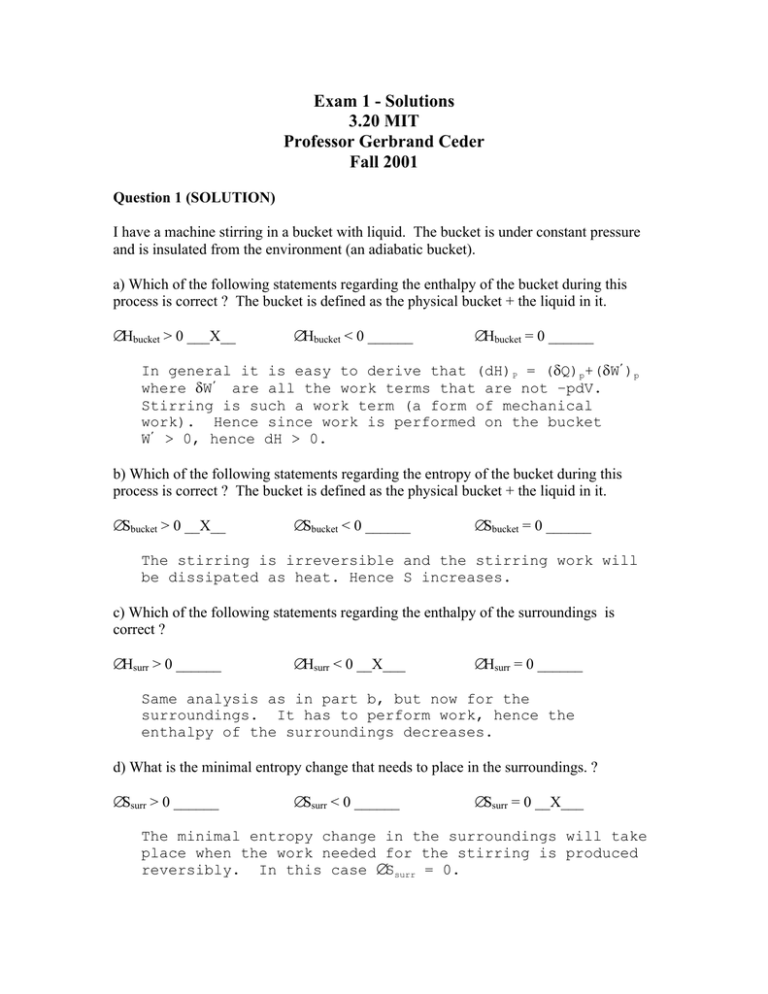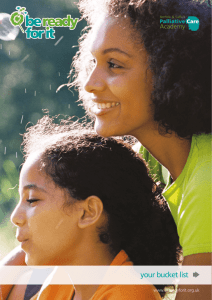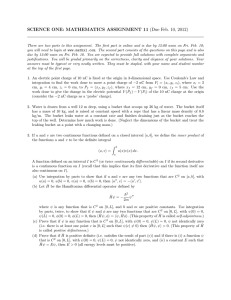Exam 1 - Solutions 3.20 MIT Professor Gerbrand Ceder Fall 2001
advertisement

Exam 1 - Solutions 3.20 MIT Professor Gerbrand Ceder Fall 2001 Question 1 (SOLUTION) I have a machine stirring in a bucket with liquid. The bucket is under constant pressure and is insulated from the environment (an adiabatic bucket). a) Which of the following statements regarding the enthalpy of the bucket during this process is correct ? The bucket is defined as the physical bucket + the liquid in it. ΔHbucket > 0 ___X__ ΔHbucket < 0 ______ ΔHbucket = 0 ______ In general it is easy to derive that (dH)P = (δQ)p+(δW’ )p where δW’ are all the work terms that are not –pdV. Stirring is such a work term (a form of mechanical work). Hence since work is performed on the bucket W’ > 0, hence dH > 0. b) Which of the following statements regarding the entropy of the bucket during this process is correct ? The bucket is defined as the physical bucket + the liquid in it. ΔSbucket > 0 __X__ ΔSbucket < 0 ______ ΔSbucket = 0 ______ The stirring is irreversible and the stirring work will be dissipated as heat. Hence S increases. c) Which of the following statements regarding the enthalpy of the surroundings is correct ? ΔHsurr > 0 ______ ΔHsurr < 0 __X___ ΔHsurr = 0 ______ Same analysis as in part b, but now for the surroundings. It has to perform work, hence the enthalpy of the surroundings decreases. d) What is the minimal entropy change that needs to place in the surroundings. ? ΔSsurr > 0 ______ ΔSsurr < 0 ______ ΔSsurr = 0 __X___ The minimal entropy change in the surroundings will take place when the work needed for the stirring is produced reversibly. In this case ΔSsurr = 0. Problem 2 (a) dU = TdS + F dl We can define G as G = U TS Fl =⇒ dG = SdT ldF We now have a potential G(T, F ) (b) Clapeyron-type equation dF d S H = =⇒ = dT dT T εV l We can integrate and get = H ln εV T2 T1 If we use the data from the problem J 300 mole H = = 530 MP a m3 εV 0.07 8 10�6 mole Now that we evaluated the constant term, we can find the upper and lower limits Upper limit: +70 MP a = 530 MP a ln Tupper 298 K Tupper = 340 K Lower limit: 20 MP a = 530 MP a ln Tlower = 287 K 1 Tlower 298 K Problem 3 First we need to find the potential that would be minimal under these conditions, namely G (constant T & P and flowing matter) � dG = SdT + V dP + i dni We are told temperature and pressure are constant, so those terms can be ignored. We now expand dG for each side of the system (called and here) dG = dG + dG dG = A dnA + B dnB + A dnA + B dnB Remember component C does not enter into the equilibrium because it cannot be moved. We now use information given in the problem to write everything in terms of dn A , namely dn A = dnA dn B = dnB dn A = dnB So now we have dG = A dnA + B dnA A dnA B dnA � � dG = A + B ( A + B ) dnA For dG to be zero, the term in brackets must be zero A + B ( A + B ) = 0 A + B = A + B Problem 4 For S(T, V ) start with the differential for S as a function of T and V ∂S ∂S dS = dV + dT ∂V T ∂T V Now all we have to do is manipulate the two partial derivatives to get them in terms of things we know ∂p ∂T ∂S ∂V V ∂p = ∂T V T 1 = � ∂V ∂T ∂V 2 p ∂p (Maxwell) T ∂p ∂T � ∂V = V ∂T ∂V ∂p p = v V v = T V T T and ∂S ∂T cv T = V Putting this all together we get dS = v T �c v dV + T dT We approach S (V, p) in the same manner ∂S dp ∂p V p ∂S ∂S ∂T = ∂V p ∂T ∂V p p ∂S ∂T cp 1 = ∂T p ∂V p T V v ∂S cp = ∂V p T V v dS = ∂S ∂V dV + (Chain Rule) and ∂S ∂S ∂T = ∂p V ∂T V ∂p V ∂S ∂T cv T = ∂T V ∂p V T v (Chain Rule) Putting all that together we get dS = cp T V v dV + cv T T v dp Note: There are other methods of getting at this answer, but they all involve starting with the differential form of dS with S as a function of the appropriate variables. The answers are equivalent if you remember the relationships between cp and cv and T and S . 3 Problem 5 We can use an ideal refrigerator. Starting with the first law, QL + QH + W = 0 and the second law QH QL + =0 TH TL TH QH = � QL TL Combining this with the first law TH QL 1 � + W = 0 TL TH � 1 QL W = TL But we can write QL as QL = dH = �AdT > 0 (minus sign because heat is given to the heat reservoir at TL and dT is negative) TH � 1 dT W = �A T � 1 TH �A � 1 dT W = T 298 � 298 TH 298 298 � 1 dT = [ATH ln T ]1 � [AT ]1 = ATH ln 298 � A(297) W = A T 1 W = 140 kJ 4



